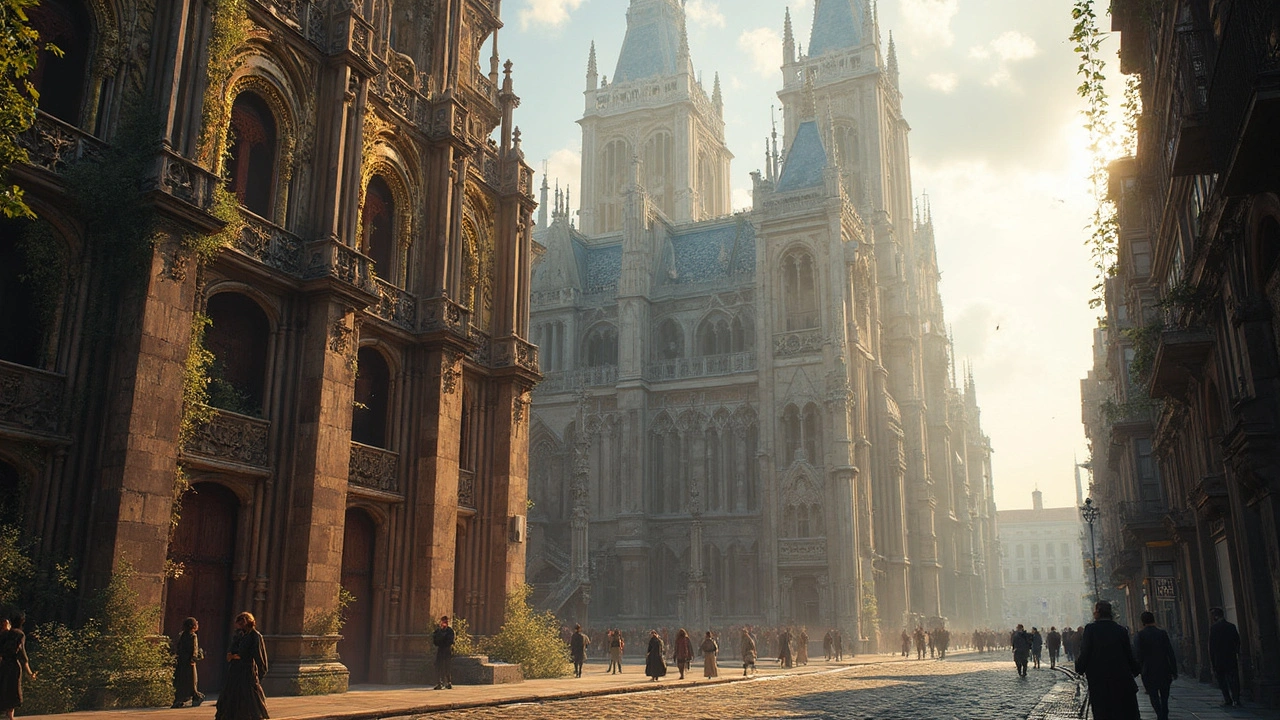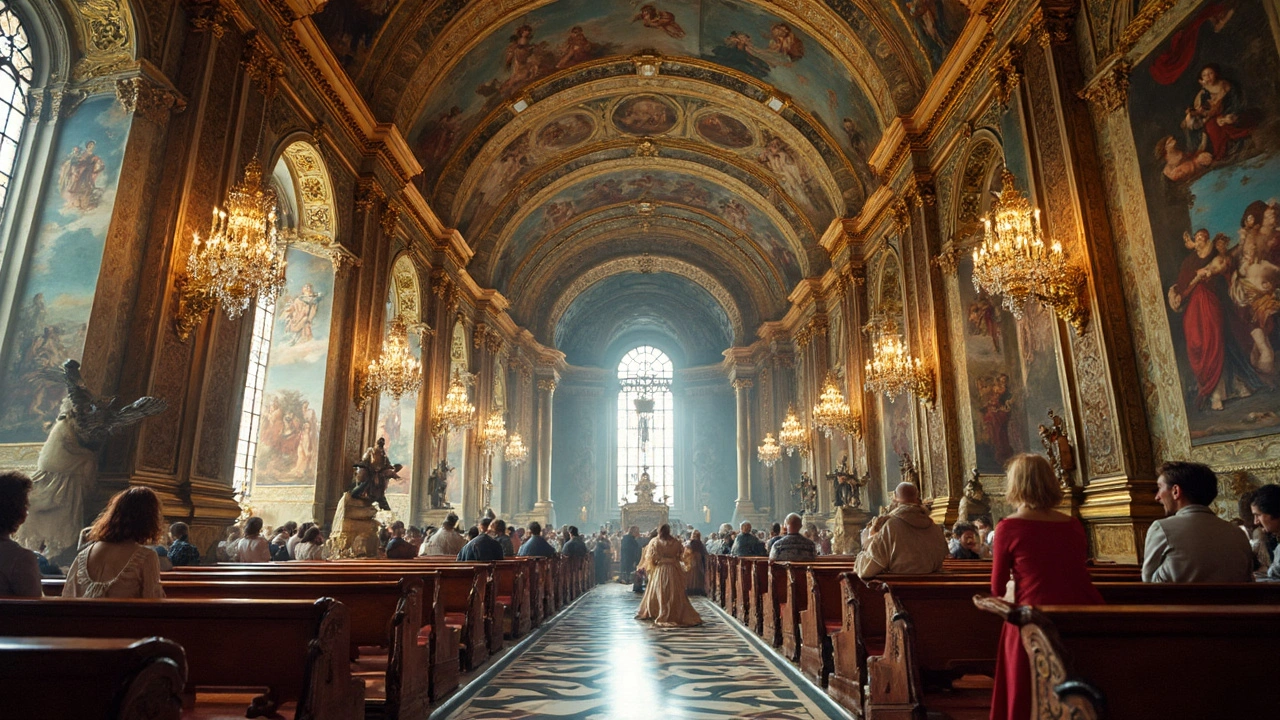Baroque Architecture: Where Art Meets Faith
 Feb, 17 2025
Feb, 17 2025
Ever wondered why Baroque architecture feels like such a visual feast? It's all about the drama and expression packed into every square inch. Born in the 17th century, this architectural style didn't just pop up randomly— it was the Catholic Church's response to the simplicity of the Protestant movement, and man, did they go all out. Think of it as the church's megaphone in stone.
The Baroque period brought a flair for the dramatic, with structures that aren't exactly shy. Curves, domes, and an abundance of ornamentation played starring roles, creating spaces that seemed to dance and breathe. This wasn't just about beauty; it was also a way to evoke emotion and communicate religious messages without uttering a word. When you walk into a Baroque church, you can't help but feel the grandiosity and, quite frankly, your own lil' place in the universe.
- The Origins of Baroque
- Key Features of Baroque Architecture
- Famous Baroque Structures
- The Legacy of Baroque
The Origins of Baroque
Baroque architecture didn't just show up out of nowhere. Its roots run deep in the late 16th century, sprouting in Italy before spreading across Europe like wildfire. If you want to put a date on it, we're looking at the period right after the Renaissance, which ended around the 1600s.
Why the switch from the calm and balance of the Renaissance to the theatrical and lavish Baroque architecture? It was a strategic move by the Catholic Church. The Protestant Reformation had hit hard, and the Baroque style was the church's way of showing power, faith, and glory through art. Imagine walking into a church and instantly feeling small and in awe—that's what they were going for.
Key Players in Baroque's Birth
One name you gotta know is Carlo Maderno. He kicked off the grand style with the facade of St. Peter's Basilica. But he didn't act alone. Gian Lorenzo Bernini, a multi-talented architect, played a huge role in shaping the style. He essentially turned Rome into a Baroque wonderland with his theatrical vision.
Across Europe, different countries added their own twists. France put an emphasis on classical roots, while Spain loved to add intricate details. It's like each region had their own Baroque recipe, with Italy serving as the main course.
The Time and Place
Baroque's timeline isn't set in stone, but you're looking at a style that thrived from about 1600 to 1750. The places where it bloomed most were cities like Rome in Italy, Seville in Spain, and even Lisbon in Portugal. Each city added its own flavor, but the goal was always the same: to inspire awe and devotion.
Overall, the emergence of Baroque wasn't just about pushing architectural boundaries. It was about expressing religious conviction and making sure everyone knew it. The style turned stones and bricks into storytellers, capturing emotions and beliefs in every ornate detail.
Key Features of Baroque Architecture
When you're strolling through a city and stumble upon a *Baroque architecture* gem, certain elements stand out as unmistakably Baroque. These buildings just scream drama and extravagance, and they have a few tricks that set them apart.
The Curve Craze
First up, Baroque architects had a bit of a love affair with curves. Forget straight lines— these guys molded facades with a wavy, flowing motion. This created a sense of movement and dynamism, making a building look like it's in action rather than just standing there.
Ornate Detail
Details matter, and Baroque architects took that to heart. Expect to see lots of intricate carvings, grand staircases, and ceilings that make your neck sore just from gawking. Everything from cherubs to floral motifs was fair game, all designed to convey a sense of heaven on earth. It's like a divine art show.
Grandeur and Scale
The Baroque style isn't about keeping it low-key. Churches, palaces, and halls are built on an epic scale, with towering columns and expansive spaces designed to overwhelm and impress. They were literally designed to make folks feel small in the presence of the divine.
Light and Shadow
The use of light and shadow (often called 'chiaroscuro' by art historians) played a huge role in Baroque architecture. Designers used lighting to add depth and drama to spaces, guiding your eyes to important details and creating an almost theatrical atmosphere. You can't help but be drawn into the ambiance.
Decorative Interiors
Step inside a Baroque building, and you're often walking into a visual story. Interiors are decked out with frescoes, marble accents, and gilded details—but it all comes together to create a single cohesive tale. Even the ceilings refused to be just ceilings— they became canvases full of stories, literally painted in the skies.

Famous Baroque Structures
When you're talking about Baroque architecture, there are certain landmarks that just have to make the list. These iconic structures aren't just buildings; they're masterpieces that have held their ground through the ages. It’s like taking a stroll through an art gallery, only everything is super-sized and made of stone.
St. Peter's Basilica
You can't talk about Baroque without mentioning St. Peter's Basilica in Vatican City, the heart of the Catholic Church. Michelangelo played a huge part in its design, especially the iconic dome. This structure screams grandeur, from its humongous columns to the majestic dome that seems to reach the heavens. It’s all about showing the power of the church and God, in a way you can’t shrug off.
Palace of Versailles
Switching gears to France, the Palace of Versailles is another stunner. While it started as a humble hunting lodge, it morphed into a palace that boasts some serious visual drama. Think of the Hall of Mirrors, where the sunlight streaming through windows meets reflections, creating a sense of infinity. It's all about displaying Louis XIV’s power and taste for flamboyance, making you feel a little royal just walking through.
Church of San Carlo alle Quattro Fontane
In Rome, you have the Church of San Carlo alle Quattro Fontane, a lovely example of how architects like Borromini twisted Baroque rules. It's pretty unique with its undulating walls and oval-shaped dome. Despite being small, this church packs a punch with its complex design.
Peterhof Palace
Heading over to Russia, Peterhof Palace often gets tagged the “Russian Versailles.” Situated near St. Petersburg, it's renowned for its lush gardens and intricate fountains that look like nature’s own ornaments, proving that Baroque wasn’t just a Western Europe thing.
These structures aren’t just reminders of artistic splendor—they’re a peek into how art and religion found a common voice. And whether you’re an architecture nut or just someone who enjoys beautiful things, a visit to any of these places is sure to knock your socks off.
The Legacy of Baroque
The influence of Baroque architecture reaches far beyond those grand old cathedrals and palaces. This style, with its dramatic flair and emotion-charged designs, forever changed how we think about public spaces, not to mention how we build them. You can see a hint of Baroque in modern architecture, all thanks to its emphasis on combining art with function.
For starters, the Baroque period blurred the lines between architectural spaces and the people who used them. Baroque architects were like the OGs of immersive design, crafting spaces that invited interaction and awe. That sense of opulence? You can still catch it in the swooping curves of some of today’s most high-end hotels and theaters.
The Global Reach
The Baroque style traveled far and wide, leaving its mark on continents beyond Europe. In America and South America, it influenced colonial architecture, embedding a taste for elaborate facades and intricate interiors. The Churrigueresque style in Mexico, for example, is a fiery cousin to the more traditional Baroque, cranking up the ornateness to another level altogether.
Cultural Impact
Perhaps the lasting wonder of Baroque architecture is its cultural significance, standing as a monument to the power and reach of the 17th-century church. It taught us that buildings aren’t just shelters—they’re stories carved in stone, wood, and stucco. They reflect the aspirations, ideals, and even the ferocity of their creators.
By weaving art with structure, Baroque opened the door for future architects to do the same. Now, we see buildings as canvases. Those bold design choices inspired generations of architects, encouraging them to break down barriers between various art forms. We'd probably still be sticking to plain, boxy buildings if it weren't for the trailblazing designs of the Baroque!